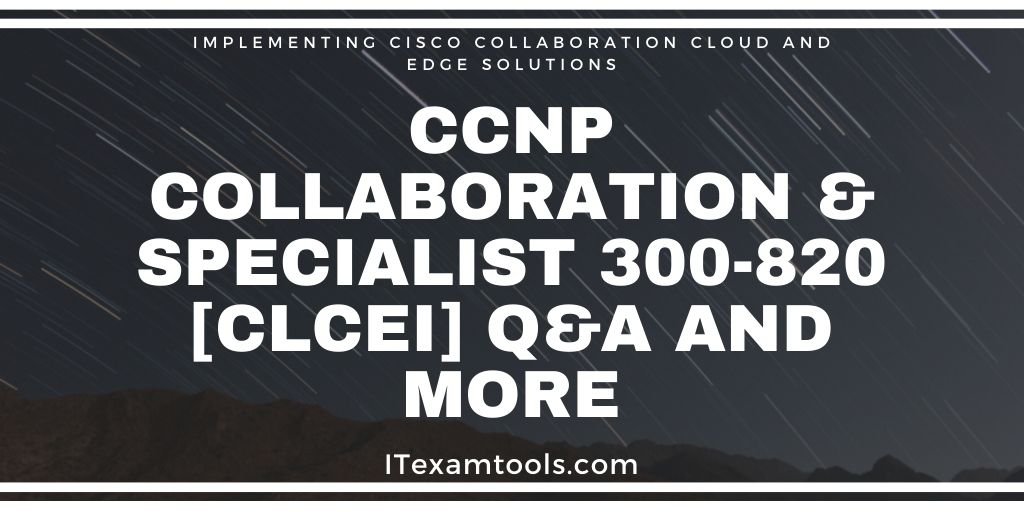CCNP 300-820 [CLCEI] Q&A and more

This exam tests your knowledge of collaboration cloud and edge solutions, including:
- Cisco Unified IM and Presence
- Expressway configurations
- Cisco WebEx Teams hybrid and emerging technologies
CLCEI – Collaboration Cloud & Edge Implementation Test complete course
300-820 Implementing Cisco Collaboration Cloud and Edge Solutions Questions & Answers
- 300-820 Practice Test 126 questions
- 300-820 Practice Test 229 questions
Description
The Implementing Cisco Collaboration Cloud and Edge Solutions v1.0 (CLCEI 300-820) exam is a 90-minute exam associated with the CCNP Collaboration and Cisco Certified Specialist – Collaboration Cloud & Edge Implementation certifications. This exam tests a candidate’s knowledge of collaboration cloud and edge solutions, expressway configurations, Cisco WebEx Teams hybrid and emerging technologies. The course, Implementing Cisco Collaboration Cloud and Edge Solutions, helps candidates to prepare for this exam.
Available Number of Questions are 55
Exam Number : 300-820
Exam Language : English or Japanese
Exam Name : Implementing Cisco Collaboration Cloud and Edge Solution
Duration : 90
Passing Score : 800 Minimum out of 1000
1 – Key Concepts
1.1 Describe the complications of NAT in a Collaboration environment
1.2 Describe the purpose of ICE, TURN and STUN
1.3 Describe Expressway media traversal
1.4 Describe protocol interworking on the Expressway
- 1.4.a SIP < > H.323
- 1.4.b IPv4 and IPv6
1.5 Describe Expressway Licensing
- 1.5.a Option keys
- 1.5.b Release key
- 1.5.c License consumption
1.6 Describe SIP media encryption mode
- 1.6.a Auto
- 1.6.b Force encrypted
- 1.6.c Force unencrypted
- 1.6.d Best effort
1.7 Describe Expressway Core dial plan elements
- 1.7.a Transforms
- 1.7.b Search rules
- 1.7.c Zones
- 1.7.d Regular expressions
- 1.7.e Pipes and links
1.8 Describe key Expressway settings
- 1.8.a DNS
- 1.8.b Network interfaces
- 1.8.c Certificates
- 1.8.d QoS
- 1.8.e Clustering
- 1.8.f Network firewall rules
1.9 Describe Expressway backup and restore procedure (stand alone and cluster)
2 – Initial Expressway Configuration
2.1 Configure key Expressway settings
- 2.1.a DNS
- 2.1.b Network interfaces
- 2.1.c Certificates
- 2.1.d QoS
- 2.1.e Clustering
- 2.1.f Network firewall rules
2.2 Configure Expressway Core dial plan elements
- 2.2.a Transforms
- 2.2.b Search rules
- 2.2.c Zones
- 2.2.d Regular expressions
- 2.2.e Pipes and links
2.3 Configure toll fraud prevention on Expressway series (no custom CPL scripts)
2.4 Configure a Business to Business (B2B) collaboration solution
- 2.4.a DNS records (focus on Microsoft DNS)
- 2.4.b Certificates (focus on Microsoft CA)
- 2.4.c Traversal Zones
- 2.4.d Neighbor Zones
- 2.4.e Transforms
- 2.4.f Search rules
- 2.4.g SIP trunk integration with Cisco Unified Communications Manager
2.5 Troubleshoot a Business to Business (B2B) collaboration solution
- 2.5.a DNS records (focus on Microsoft DNS)
- 2.5.b Certificates (focus on Microsoft CA)
- 2.5.c Traversal Zones
- 2.5.d Neighbor Zones
- 2.5.e Transforms
- 2.5.f Search rules
- 2.5.g SIP trunk integration with Cisco Unified Communications Manager
3 – Mobile & Remote Access
3.1 Configure a Mobile and Remote Access (MRA) solution
- 3.1.a DNS records types (not platform-specific)
- 3.1.b Certificates (not platform specific, covers Unified Communications Manager, IM&P, Expressways, Unity Connection)
- 3.1.c Unified Communications traversal zones
- 3.1.d Unified Communications configuration on Expressway
- 3.1.e HTTP allow list
- 3.1.f SIP trunk security profile on Cisco Unified Communications Manager
3.2 Troubleshoot a Mobile and Remote Access (MRA) solution
- 3.2.a DNS records (focus on Microsoft DNS)
- 3.2.b Certificates (focus on Microsoft CA, covers Unified Communications Manager, IM&P, Expressways, Unity Connection)
- 3.2.c Unified Communications traversal zones
- 3.2.d Unified Communications configuration on Expressway
- 3.2.e HTTP allow list
- 3.2.f SIP trunk security profile on Cisco Unified Communications Manager
4 – Cisco WebEx Technologies
4.1 Describe the signaling and media flows used in a Cisco WebEx Video Mesh deployment
4.2 Configure WebEx Hybrid Services/Connector
- 4.2.a Calendar Service (Office 365, Microsoft Exchange, One Button to Push)
- 4.2.b Message Service (Deployment requirements; expressway requirements, certificates, Call Manager pre-requisites, IM&P prerequisites, deployment models)
- 4.2.c Directory Services (Deployment requirements; deployment models, infrastructure requirements, active directory configuration, synchronization, WebEx user service assignment)
- 4.2.d Video Mesh (Deployment requirements including; bandwidth, clustering, endpoint support, video call capacity, ports and protocols, deployment models)
4.3 Describe Cisco Jabber for Cloud and Hybrid deployments with Cisco WebEx Messenger